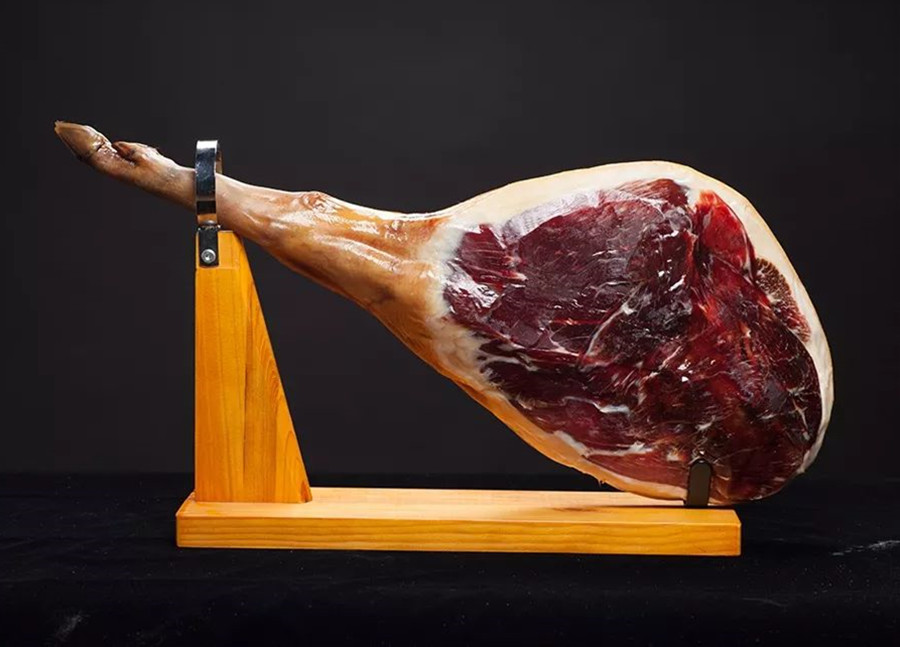Since humans discovered that they can be cured and dehydrated with salt to extend the shelf life of meat, the world has added a delicacy-ham.
The history of making ham in Italy is said to date back to ancient Greece, while Chinese ham has been documented in the Tang Dynasty. In addition to Spanish Iberian Iberico ham and Chinese Jinhua ham, what else is there?
Jinhua Ham
Jinhua ham is produced in Jinhua, Zhejiang, which has been the place where China’s economy and culture have prospered since ancient times. Therefore, Jinhua ham has been known as the most famous ham in China for thousands of years. It was listed as a tribute from the Song Dynasty to the Qing Dynasty, and Jinhua ham was also mentioned in “A Dream of Red Mansions”. In 1905, Xuefang Jiang’s legs also represented Jinhua Ham and won the gold medal at the Leipzig World Exposition in Germany, which is well-known both in China and abroad.
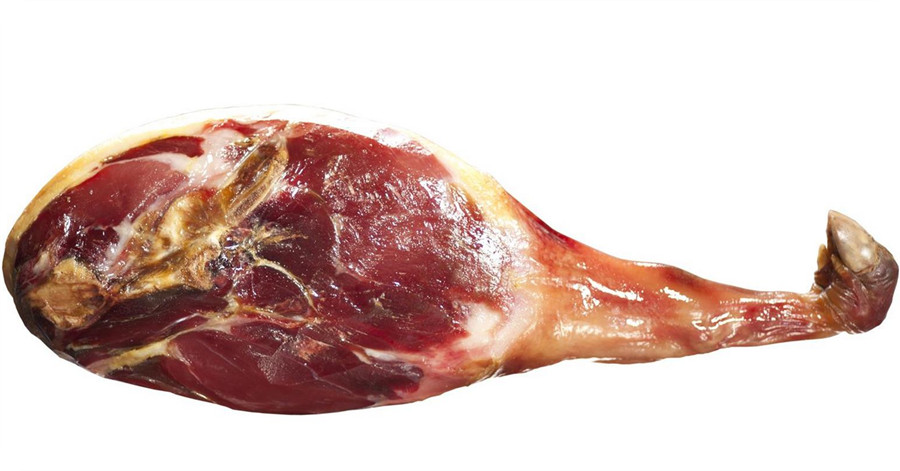
1. Complex Processing
The pig breed that must be used to make Jinhua ham is the “two-headed black” (black hair on the head and buttocks), which is characterized by thin skin and thin skeleton, rich fat, and sweet and fragrant taste. Jinhua ham only uses fat, tender pork hind legs, and 5 to 9 kilograms of pork legs are the first choice. After more than 80 processes such as pickling, washing legs, air-drying, putting on shelves and fermenting, the traditional method takes 8-10 months.
2. Savory and Sweet
The most famous of Jinhua hams is “Xuefang Jiang’s Legs”. It was founded by Jiang Xuefang, a businessman in Shangjiang Village, Dongyang. In 1905, he won the gold medal at the International Fair in Leipzig, Germany. And in 1915 participated in the Panama International Commodity Fair also won the gold medal. It is still in production today.
Jinhua ham has a darker color. Due to the influence of Jiangsu and Zhejiang flavors, the lean meat is salty and sweet, and the fatty meat is fragrant but not greasy. But the saltiness is more prominent in ham, and it is generally not used as a main dish, but only used as a side dish to enhance flavor.
3. Honey Sauce Ham Square
Jinhua ham can be divided into five parts: fire claw, ham heel, upper square, middle square and drip oil.
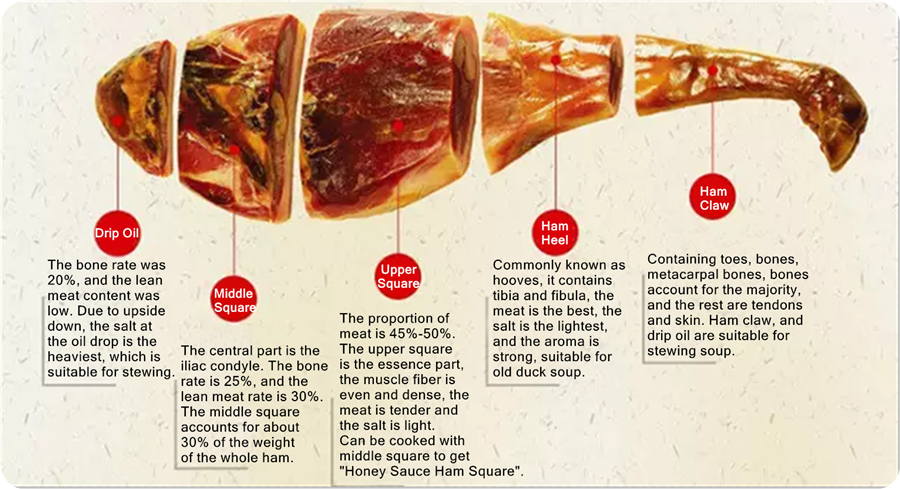
“ham claw” and “drip oil” can be stewed in soup, and “middle square” is usually made into shreds, slices, strips or pieces. The “upper square” muscle fibers are uniform and dense, and the meat quality is the best. It can be used for cutting large slices, flower-shaped slices, etc. “ham heel” can be stewed whole or cut into pieces, cut into semi-circular slices, round slices, etc. Most of them are eaten with the skin, so the fire power need to be enough.
The famous dishes made with Jinhua ham, except for “Buddha jumping over the wall”, are “honey sauce ham square”. Steam the “upper square” with sugar lotus seeds first, then add lard and pine nuts to deep fry until golden, and finally add honey and sugar sweet-scented osmanthus to thicken it.
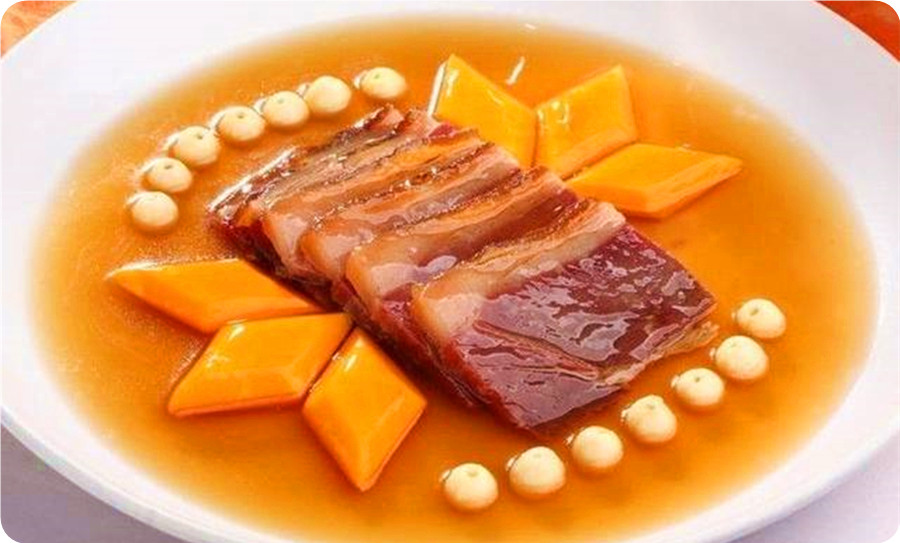
Xuanwei Ham
Excluding Jinhua ham, the second most famous ham in China is Yunnan’s Xuanwei ham. Together with “Jinhua ham” and “Anfu ham”, it is known as the three most famous ones in China.
The reputation of Xuanwei ham is inseparable from the food competition held in Guangzhou in 1923 from all over the country. At this meeting, Mr. Sun Yat-sen tasted it. He thought it was fresh, tender and sweet. He appreciated it and left the inscription “Drink and Food Virtue”. The factory that uses Xuanwei ham to make Yunnan ham canned food is also named “Dehe Cannery” and has survived to this day.
1. Favorable Timing and Location
Xuanwei is located in northeastern Yunnan with an altitude of more than 2,000 meters. The climate is cold in winter and is suitable for curing bacon. The curing time of Xuanwei ham is from the beginning of the frost to the end of the beginning of spring every year, mainly from the winter solstice to the small cold period. The pickling method is to slaughter the local pigs, squeeze all the blood, put salt and rub. Then it goes through the processes of pickling, fermentation, and air-drying, and is pickled after the Dragon Boat Festival the following year.

The pig breed of Xuanwei Ham adopts the unique local breed “Wujin Pig” of Wumeng Mountain. But the most important part of the formation of ham flavor is the fermentation process. The microbiological research of Yunnan Province shows that the main series of different types of hams at home and abroad have similar ingredients, but the non-main series ingredients (nutrients, color and flavor) are different due to different fermentation methods. Outsiders who come to Xuanwei to learn can use its processing technology, but the processed ham is not stored and fermented in Xuanwei, and it is impossible to make authentic Xuanwei ham.
2. Three-year “Old Ham”
Xuanwei ham usually uses “old ham” that has been cured for three years. It is shaped like a pipa, with only large bones and small bones, with thin skin and moderate thickness and fatness. The meat matured for one to three years is softer, the cut section has a strong aroma, and the color is bright. The lean meat is bright red or rose, the fat is milky white, the bones are slightly pink, and the taste is salty and natural. The ones that are more than three years old will dry for longer, have a stronger fragrance, and can even be eaten raw. But the taste is too salty, the meat is hard, and even requires a saw.
However, traditional Xuanwei ham will have a faint mildew stain on the surface, which is used to maintain the quality and not spoil, and is not a sign of deterioration. Just scrape off the mold on the surface when eating.
Nodun Ham
Nuodeng is a Bai village located north of Yunlong County, Dali Prefecture, Yunnan Province. It is also called Dengjing and is one of the five famous salt wells in Yunnan. Nuodeng ham was originally hidden deep in the mountains for hundreds of years and unknown, but after the 2012 gourmet documentary “China on the Bite of the Tongue” was broadcast on CCTV, this ancient town in the deep mountains and its exquisite ham immediately became popular all over the country.
1. Millennium Salt Well
Nuodeng has moderate rainfall, mild climate and short frost period, which is just right for deep fermentation. Outside of the climate, Nuodeng ham uses pure grain-fed pig hind legs as the material, and only uses fontanine salt from the millennium salt well in Nuodeng Village to pickle it. Nuodeng Well Salt does not contain iodine, but it is rich in potassium. In the dry season, the locals go to the well to draw water and boil it into large chunks in an iron pot-this is the so-called “pot bottom salt.” You can still buy salt blocks handmade by villagers when you travel to Nuodeng.
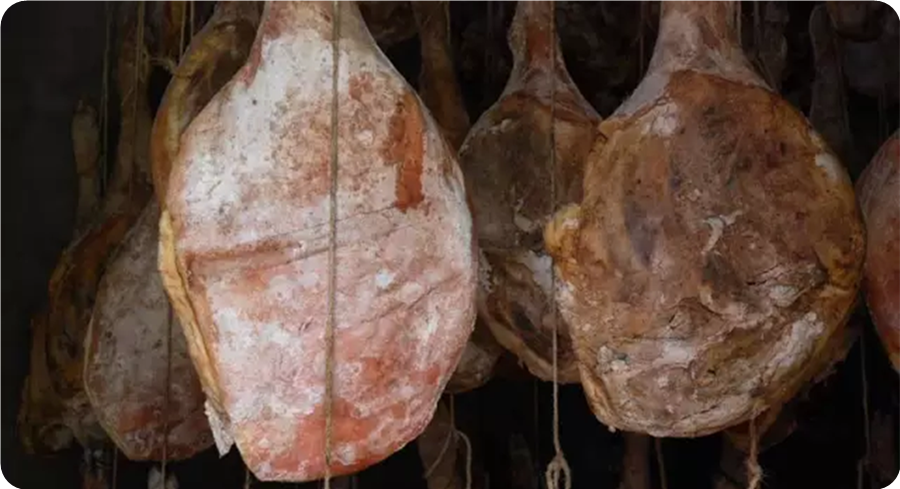
The method of curing is also very unique, commonly known as “Nuodeng ham sold in mud”. When pigs are killed every winter, they are marinated with salt and Baogu wine. The Nuodeng people put the pork leg skin down in a wooden vat or a large iron pot, covered with a lid, and marinated for 15-20 days. After taking it out, first smear a layer of salt, and then evenly smear a layer of thin mud mixed with stove ash and the mud precipitated under the Nuodeng brine. This thin mud has the functions of preservation, accelerating fermentation and preventing insects. Then hang it with a rope in a cool, ventilated place for more than half a year. The longer the storage time, the stronger the fragrance.
2. The Flavor is Comparable to Spanish Ham
Nuodeng ham is one of the three major hams in Yunnan. Because it has less salt and shorter curing time than Xuanwei ham, the meat is more tender. Moreover, Nuodeng ham that is more than three years old can be eaten raw. It is known as “the only Chinese ham that can be compared with Spanish ham, and only Nuodeng ham”.
The biggest problem with Nuodeng ham is that the village is very small and the population is small, and the villagers produce and sell it by themselves. The salt well salt is insufficiently produced, which has caused the local production of ham to be in a small workshop-style low-yield state for a long time. Authentic Nuodeng ham The output is extremely low. Especially after the fire of “A Bite of the Tongue”, various fake and inferior products have emerged in endlessly. If you can’t find a reliable purchase, it is best to look for the only Nuodeng ham factory in Yunlong County.
3. Fried Rice with Ham
Similar to Xuanwei ham, Nuodeng ham can be eaten by frying, frying, or deep-frying. The tender meat at the center closest to the bone can even be thinly sliced and eaten raw. In “China on the Bite of the Tongue”, the villagers showed us the local method of fried ham with lettuce and fried rice with ham.
Ham Fried Rice Mix the diced ham and hot rice, then pinch it into a strip, similar to Japanese rice balls. Eat it while it’s hot, the oily scent of ham is soaked in the rice, and the air is so intoxicating.
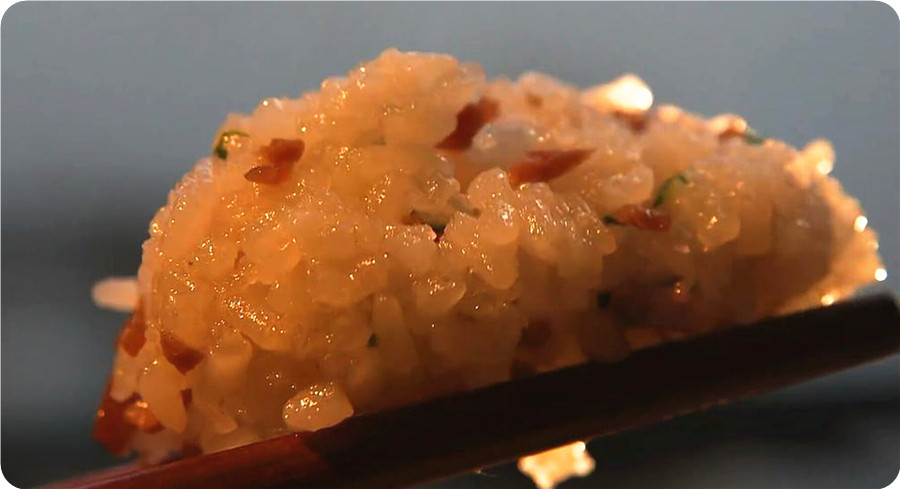
Iberian Ham
Food industry associations in Europe and the United States have strict supervision and detailed classification. Spanish ham is divided into two main categories, Iberian ham and Serrano ham, and there are many subdivisions. What is the difference between these hams, let us explain in detail.
1. Black Pig Acorn Feeding
Iberian ham is made from local black hoofed pigs (pata negra) of more than 75% ancestry, while Serrano is white pigs or other mixed pigs. The former is less, more elaborate and more expensive. According to the position, it can be divided into front legs and back legs. Jamón refers to the back legs of pigs, and paleta refers to the front legs. The hind legs are fatter and more expensive, but the front legs are also made into ham.

Iberian ham is characterized by black hoof pigs and acorn-fed. There are six specific levels:
- Jamon Iberico Bellota (Top Grade Iberian Ham). Bellota is an acorn. The selected black hoof pigs are stocked and feed on grains and acorns. During the acorn ripening season (October to January), the pigs are allowed to eat acorns at will. Each pig has at least half a hectare of oak forest. Depending on the place of origin, 50-65% of the food eaten is acorns, and during this period the weight increased from 80-105 kg to 150-180 kg can be called Jamón ibérico de bellota.
- Jamon Iberico Bellota Paleta (Top Iberian Front Leg Ham).
- Jamon Iberico Recebo (Premium Iberian Ham).Black hoofed pigs are stocked and feed on grains and acorns, but they do not reach the legally labelable acorn ham grade.
- Jamon Iberico Recebo Paleta (Premium Iberian Front Leg Ham)
- Jamon Iberico Cebo (Iberian Ham). It is raised in pig farms and uses grains as feed.
- Jamon Iberico Cebo Paleta (Iberian Front Leg Ham)
The naming and grading follow the Spanish Denominación de Origin system, so you can know the grade by looking at the sign when you buy it. The production areas are mainly four major production areas, all in the west of Spain. In fact, there is a barcode on each leg, which can be traced back.
In addition to strict selection of materials, the production process is also strict in quality control. The curing process of Spanish ham is probably to sprinkle with sea salt first, wash it off with warm water a few days later, and then place it in a room with high temperature and humidity for slow dehydration for 1-2 months. Then it will be changed to 15-30 degrees under natural environment and matured for 6-12 months, dehydration accelerates the fat exudation. This is the end of Serrano ham. The iberico ham will then hang back into the cellar to grow mold and slowly mature at 10-20 degrees for about 2 years to increase the flavor.
2. Fat Penetrates into Muscles
The top Iberian pigs run 14 kilometers a day during the mountain grazing and have 2 hectares of free grazing area. On the one hand, this exercise creates a tight appearance of pigskin and slender ankles (the longer the ankle, the purer the race). On the other hand, the walking of 100% Iberian pigs makes the fat penetrate the muscles, resulting in red and white. Intramuscular fat is not slippery, and the texture of the fat can be known at the touch of a touch. Acorn feeding also gives the meat a more complex and chewy flavor in addition to the fresh aroma of ham.
3. Served Raw with Wine
Iberian ham is best cut by a certified ham chef and eaten raw, and it is best to put it on a lukewarm plate. Serving with bread and beer is a popular way to eat it. It can also be a starter appetizer, or a little rice for the Chinese. Pair with iced Jerez or Spanish Rioja wine.
The authentic way to eat in Spain is to make tapas. Classic tapas, such as salmorejo, use tomato-based cold cream, Cordoba bread crumbs or bread crumbs, virgin olive oil, garlic, and salt, with small slices of bread, sliced boiled eggs, and Iberian ham.
Parma Ham
Prosciutto is Italian ham. The most famous ones come from central and northern Italy. They are Parma from Emilia-Romania and San Daniele from Friuli-Venezia Giulia. Parma ham is a protected designation of origin in the European Union. The trademark is a golden crown with “PARMA” written on it. It is called “Hermes in ham”. The latter is relatively less well-known, but the quality is also very good.

1. Sweet Ham with Sea Salt
Parma ham must be taken from specially raised Landrace, Large White and Duroc pigs. These pigs are born and raised on authorized farms located in ten regions of central and northern Italy. The pig’s diet is also specially controlled, mixing grains, miscellaneous grains and whey leftover from the production of Parmesan cheese to ensure that every high-weight pig grows appropriately every day in a healthy state.
Because the mountain climate is not conducive to the growth of bacteria, Parma does not use much salt compared with other hams, so it is also called prosciutto dolce (sweet ham). Making Parma ham is a lengthy process. The production time depends on the size of the legs and the weather during the production period. It takes 9 months to two years. First, wipe Shanghai salt, leave it for two months, and remove its blood. After that, the sea salt is washed off and dried slowly in a dark, low temperature and cold environment. The entire process of pickling and air drying lasts at least 12 months. When the ham is completely dry, the weight will be reduced to a quarter of its original weight, and the ham will be softer and have a unique fragrance. Nowadays, sodium nitrite or potassium nitrite is also used to make the ham have a rose-like color, but the authentic Parma ham only uses sea salt.
2. Marble Texture of Fat
Parma ham is a ham that can be eaten raw, that is, prosciutto crudo, just cut into thin slices. The slicing technique of ham is also an art. Although there are slicers, the cut ham cannot achieve the effect achieved by the cooperation of the knife and the strength. Many restaurants still prefer to slice by hand and perform wonderful performances. The cut ham is thin, translucent, complete, and does not break. The ham with a slight bump on the surface tastes more textured.
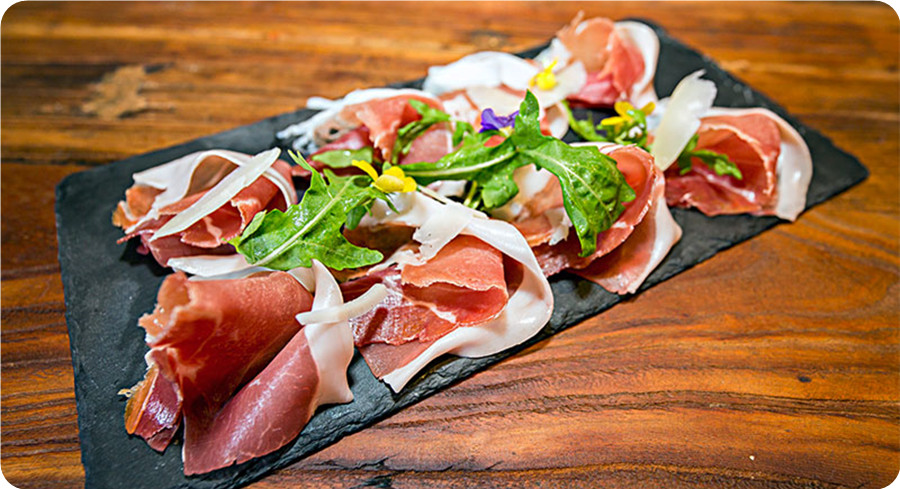
The best Parma ham must be at least 9 kilograms or more, dark red in color, transparent after being sliced, and fat with marble texture. It smells of old meat and smoky smell, the mouth tastes salty, the fat can be dissolved in the mouth, and it has an aftertaste.
3. Raw Ham with Honeydew
There are many ways to eat Parma ham in Italy, such as making a salad or eating it directly with buffalo cheese. Of course, the traditional Italian pizza made with Parma ham and mozzarella cheese is definitely worth a try.
Parma ham can also be eaten with fruit, the classic such as ham with cantaloupe, its flavor is refreshing and fragrant. There are also other methods, such as the use of cantaloupe soup and breaded ham slices, and there are many ideas

